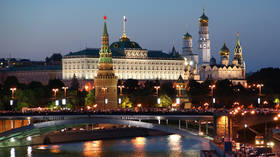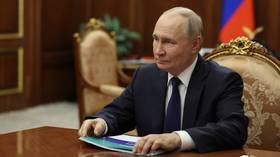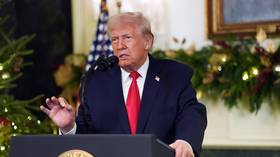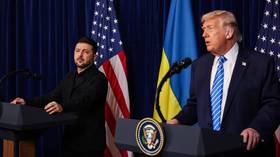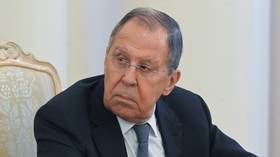Syria’s sarin whodunit: Assigning responsibility for war crime
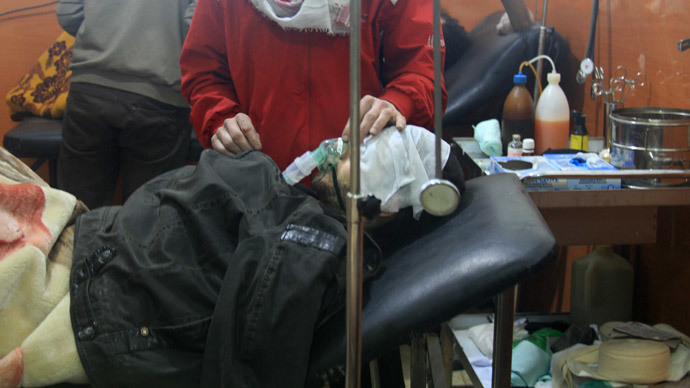
Who crossed the red line in Syria? Figures within US intelligence circles may know who engineered the August 21 chemical attack in Ghouta, but the Obama administration has a stake in making sure the responsible parties are not held accountable.
For a few days last summer, the United States teetered on the precipice of a decision that would have profound ethical, political and security implications. The Obama administration claimed to have an ironclad case against the Syrian government, who it said was the only party that could have been responsible for carrying out an attack using sarin nerve gas in Ghouta, an eastern suburb of Damascus.
US spokespersons regarded any question of the Syrian government not being responsible for the attack as a preposterous notion, while Secretary of State John Kerry spoke at length of the moral imperative to respond militarily.
President Obama’s ‘red line’ had been crossed, prompting him to unveil plans for allied airstrikes across Syria to ‘punish’ the government of Bashar Assad. The administration aggressively asserted its stance – that Assad, and only Assad, could have used sarin – in the days following August 21, only for Obama to call for congressional approval for the intervention less than two days before the planned strikes. The congressional vote was called off once Washington agreed to a UN-backed plan to dismantle Syria’s chemical arsenal.
If the administration was so confident of its assessment of the events that unfolded on August 21, what influenced Obama to cancel his plans for military action? If the president chose not to consult Congress prior to his approval of intervention in Libya, why did he feel compelled to ask for congressional approval to strike Syria in the face of what the administration considered an egregious violation of his ‘red line’?
Despite the unrelenting resolve of Washington that the Syrian government committed a heinous crime, why has the White House failed to provide any additional evidence of Syrian involvement in the sarin attack since the airstrikes were canceled?
A groundbreaking exposé on the US administration’s Syria policy recently published by Pulitzer Prize-winning investigative journalist Seymour Hersh clarifies some of these queries. Hersh’s article – ‘The Red Line and the Rat Line’ – appears in the London Review of Books, and cites well-placed former US intelligence officials speaking on condition of anonymity to provide a plausible rendering of the August 21 sarin attack and what happened behind the scenes in Washington thereafter.
Whose sarin?
According to Hersh’s sources, the Obama administration received reports from British intelligence experts shortly after the events of August 21. The results of their analysis confirmed that the gas used did not match the substances known to exist in the Syrian army’s chemical weapons arsenal.
Contrary to the official US stance, which claimed that Assad’s forces were the only party with the capability to launch sarin attacks, intelligence circles in Britain and the US became aware that rebel units in Syria such as the Al-Nusra Front had been developing chemical weapons since the spring of 2013.

Hersh claims that analysts from the US Defense Intelligence Agency (DIA) were already aware by June 2013 that Al-Nusra Front’s sarin production unit was “the most advanced sarin plot since Al-Qaeda’s pre-9/11 effort,” and that Turkey and Saudi-based chemical facilitators were attempting to purchase sarin chemical precursors in bulk for anticipated production efforts inside Syria.
A source formerly high-level within the Defense Department told Hersh that White House Chief of Staff Denis McDonough ordered the publishing of intelligence pertaining to chemical weapons be blacked-out and restricted in the DIA’s daily briefs on Syria following small-scale sarin attacks in March and April. Carla Del Ponte, the UN inspector who investigated the earlier attacks, would later claim that evidence she compiled suggested that rebels had used the weapons.
Hersh’s sources claim that members of the Syrian opposition in exile became frustrated how earlier Western intelligence assessments failed to conclude that sarin had been used, keeping Obama’s ‘red line’ technically intact. Following the events of August 21, the Syrian opposition claimed that sarin had been used before any analysis had taken place, while the White House backed the claim, endorsing it from the outset.
Hersh’s sources also claim that US intelligence officials were aware since spring of 2013 that the Turkish government and its intelligence services were working directly with Al-Nusra Front and its allies to develop a chemical warfare capability. Turkey’s Prime Minister Tayyip Recep Erdoğan, who adopted a strong position against Damascus from the onset of the conflict, was said to be highly frustrated by the rebels losing ground against Syrian government forces and felt that intervention served as the only reliable route to neutralize Assad. Hersh cited a former US intelligence official in his report who told him, “We knew there were some in the Turkish government who believed they could get Assad’s nuts in a vice by dabbling with a sarin attack inside Syria – and forcing Obama to make good on his ‘red line’ threat.”
‘Monster strike’ averted
Hersh’s report reveals how the question of enforcing Obama’s ‘red line’ polarized the US establishment. On the one side, figures in the White House were committed to military intervention despite probably being aware that Turkish intelligence played a role in engineering the August 21 attack that crossed the ‘red line’. On the other, Pentagon officials who felt that the evidence to support claims of Assad’s complicity were weak and that military strikes would be a disastrous shortcut to a wider regional war. The latter’s advice was ultimately heeded by President Obama, who likely felt that the costs of intervention would ultimately undermine his position and create disastrous political consequences that would necessitate a greater US military commitment.
In the face of too many unknowns, Obama looked for a way to backpedal out of his vow to strike Syria militarily, which culminated in his calls for congressional approval and the subsequent endorsement of the UN-backed disarmament plan. Although Obama backed off military intervention for purely pragmatic reasons, Hersh’s exposé details how the administration was willing to target military and civilian infrastructure, and enact airstrikes that would have incurred significant civilian causalities – all to ‘punish’ Assad and topple his government.
The White House allegedly dismissed the Pentagon’s initial suggestions of airstrike targets over concerns that their plans would be insufficiently “painful” to Syrian forces, and pressured the Pentagon to revise their list of targets, creating what a former intelligence official called “a monster strike” scenario. The attack plans called for two wings of B-52 bombers, navy submarines and ships equipped with Tomahawk cruise missiles to target electric power grids, oil and gas depots, all known logistic and weapons depots, all known command and control facilities, and all known military and intelligence buildings.

The governments of Britain and France were enthusiastic and deeply committed to taking part in the planned American air war. Hersh’s sources claim that General Martin Dempsey, the officer charged with planning and executing the proposed Syria strikes, reacted skeptically toward the administration’s claims that Assad used chemical armaments and called for more evidence. Dempsey allegedly believed that Assad was winning the war and wouldn’t have used sarin at that stage of the conflict, and repeatedly warned Congress of the dangers of militarily intervening in Syria.
Hersh claims that the initial tests on sarin samples conducted by British intelligence, which vindicated Assad, influenced the US Joint Chiefs of Staff to persuade Obama into canceling the strikes, which would have ultimately been considered an unjustified act of aggression.
Erdogan’s false flag
As a key actor in the destabilization of Syria, the government of Turkey has materially assisted and trained various rebel factions, allowing militias to be based in and around southern Turkey near the border with Syria. Erdogan was known to be increasingly frustrated by the rebels’ inability to hold their ground on the battlefield, and irritated by the CIA’s inconsistent stream of weapon shipments and supplies. Sources claim that his administration feared a blowback scenario, in which Assad’s forces would ultimately win the war and consolidate control over the country, prompting the remaining radical fighters to scatter and regroup on the Turkish side of the border.
“Erdogan’s dream of having a client state in Syria is evaporating and he thinks we’re the reason why. When Syria wins the war, he knows the rebels are just as likely to turn on him – where else can they go? So now he will have thousands of radicals in his backyard,” claims the former intelligence official in Hersh’s exposé. The source claims that senior US military officers were informed by the Defense Intelligence Agency that Turkish intelligence operatives supplied the sarin used on August 21, an assessment that was further corroborated through intercepted conversations in the immediate aftermath of the attack that saw Turkish officials claiming credit for the operation’s success.
Prior to the publication of Hersh’s report, professors at the Massachusetts Institute of Technology (MIT) authored an investigation of the August 21 attack. Richard Lloyd, a former UN weapons inspector, and Professor Theodore Postol studied the rockets used in the attack and their trajectories, and concluded that the sarin could not have been fired from Syrian government territory as the White House claimed.
The sequence of events reported by Hersh becomes all the more conceivable in light of the recent audio leaks of a conversation that appears to show Turkish ministers talking about engineering a crisis to provoke military intervention in Syria. As a NATO member and a key player in the war against Assad, the Obama administration would not likely hold members of the Turkish government to account if they indeed engineered the August 21 attack.
The extent of the Obama administration’s foreknowledge and complicity in the operation may never be fully ascertained. The way the White House quietly distanced itself from the assertions made by top administration officials following August 21 attack, and their failure to make available any new evidence to implicate Assad, suggests that the official narrative had unraveled past the point of being salvageable.
Hersh’s assessment of the August 21 attacks present a parallel version of recent history that will be written about for decades to come, and it is now the responsibility of academics, journalists and activists to establish the truth, and to hold the perpetrators of a war crime accountable for their actions.
The statements, views and opinions expressed in this column are solely those of the author and do not necessarily represent those of RT.
The statements, views and opinions expressed in this column are solely those of the author and do not necessarily represent those of RT.




